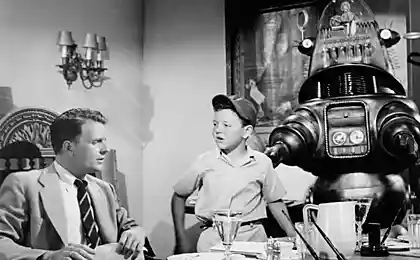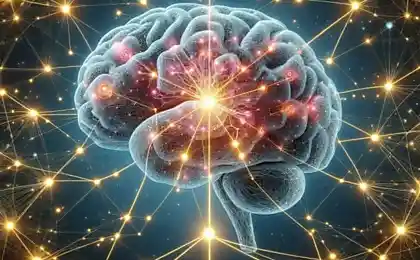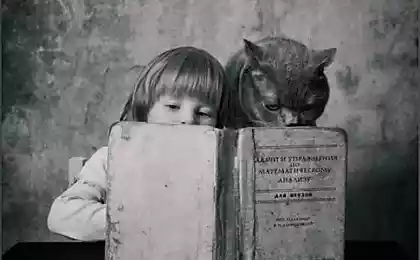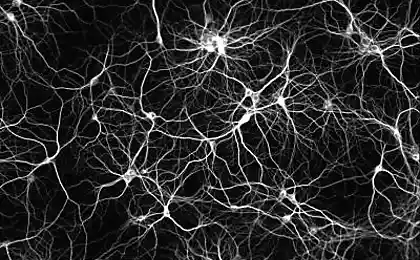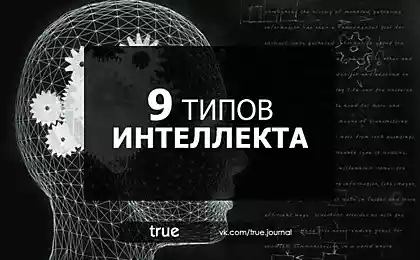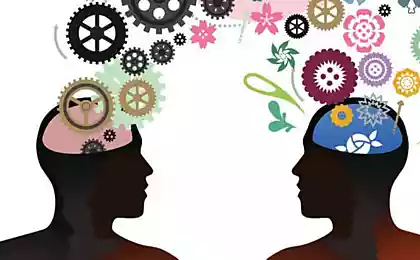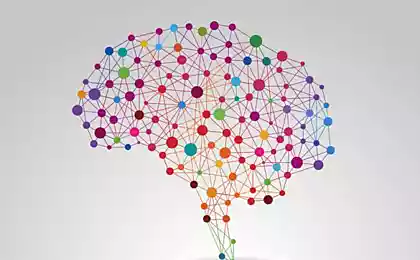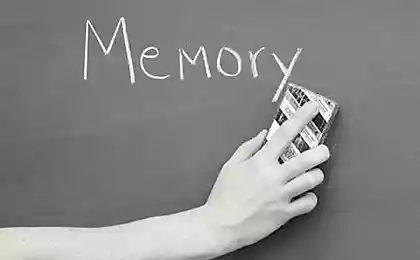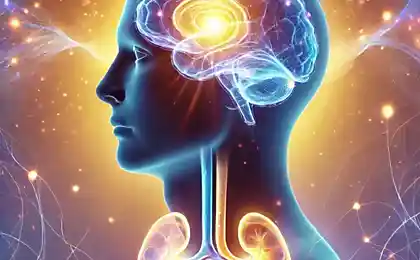1874
The logic of thinking. Part 14. Hippocampus
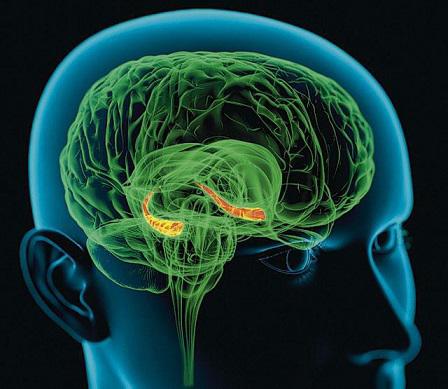
This series of articles describes the wave model of the brain, is very different from traditional models. It is highly recommended for those who just joined, start reading from the first part of the .
Complete removal of the hippocampus makes it impossible to form new memories that convincingly demonstrated the case with the patient HM Irregularities in the hippocampus can lead to Korsakoff's syndrome, which is also reduced to the inability to capture current events, while preserving the old memory. All this convinces us that the hippocampus plays a key role in the mechanism of memory.
Traditional theories about the role of the hippocampus are based on the analogy of the brain and a computer. In such reasoning hippocampus plays the role of "memory", that is the place where new memories are accumulated. Then, as alleged in the dream, those memories are transferred to the area of the brain responsible for long-term memory storage. Although the mechanisms of this transfer are not clear, but at least it helps explain why the disruption of hippocampal memory blocks the formation of the event.
Our model is fundamentally different from traditional models. We are not going no buffer memory in the hippocampus and its subsequent copying. Elements forming memories, once formed, where they remain appropriate. The hippocampus is thus simply generates a unique identifier that combines spatially distributed memory elements cortex. Wave model of the brain explains how this identifier is distributed throughout the cortex. The presence of such an identifier allows selecting them combined elements play no abstract painting, a concrete image of the stored events.
In 2010 were made interesting experiments on rat hippocampal prosthesis (Theodore W. Berger, Robert E. Hampson, Dong Song, Anushka Goonawardena, Vasilis Z. Marmarelis, Sam A. Deadwyler, 2011). Experimental animals on both sides of the brain in the hippocampus introduced microelectrode arrays, exciting area CA3 and CA1. After the rats recovering from surgery, began a series of tests.
Rats are placed in a chamber with two retractable levers. The test consisted of three phases. First randomly nominated one of the levers. When the rat pressed the lever, fixed pattern of activity of the pre-selected hippocampal neurons (stage sample). Then the lever was removed, and a pause from 1 to 30 seconds in one series and up to 60 others. Then both levers nominated. When you press the lever opposite the original model was issued reinforcement in the form water droplets. If an error occurs, that is pressed on the same arm that was at the stage of the sample, followed punishment - turning off lights for 5 seconds. In a graph of the results is the success of attempts on the delay time (see Figure below).
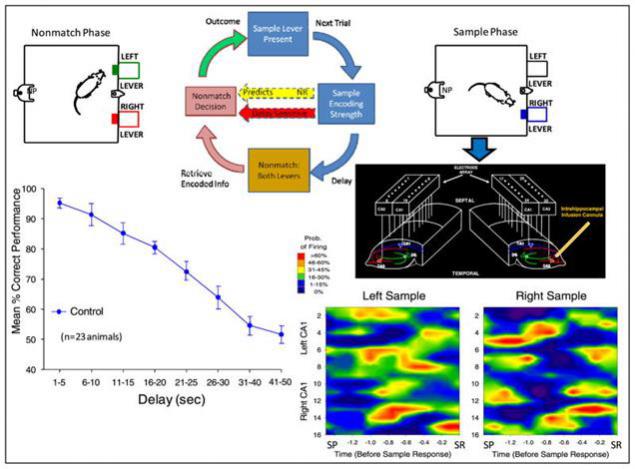
Control measurements of the natural activity of the hippocampus (Theodore W. Berger, Robert E. Hampson, Dong Song, Anushka Goonawardena, Vasilis Z. Marmarelis, Sam A. Deadwyler, 2011) i>
On the basis of the recorded signals was composed predictive model that predicted which signal should wait on CA1 depending on the signal CA3. In a series of experiments, the forecast signals were added to the existing signals (see Figure below).
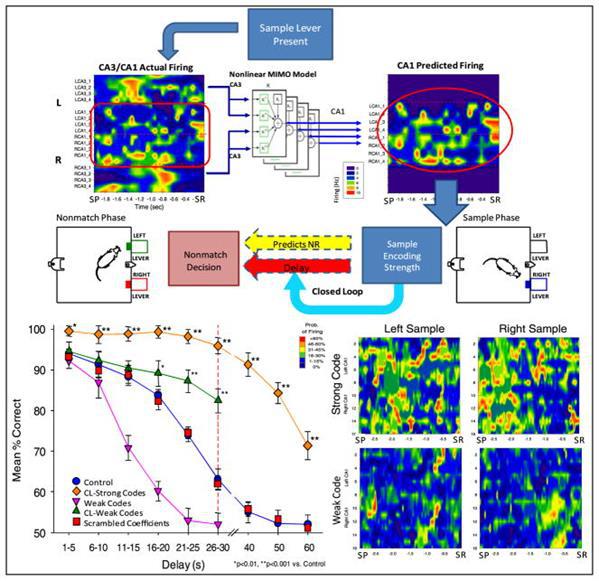
The addition of artificial signals (Theodore W. Berger, Robert E. Hampson, Dong Song, Anushka Goonawardena, Vasilis Z. Marmarelis, Sam A. Deadwyler, 2011) i>
Interesting results. It was found that a significant effect on the result is only when adjusting the signal bringing the sample stage, that is, when remembering the original image. Picture of the same signals in other moments were not critical. Moreover, the stronger was the correction signal, the better was the final result.
The authors of the experiment, explain the results, based on the concept that the hippocampus is involved in encoding the current information, preparing them for entry into memory. What picture of activity observed in the hippocampus, are informative description of the events. Accordingly, strengthening the "right" signal improves the results of memorization.
In our model, an explanation of the results is somewhat different. It is understood that the identifier of the hippocampus is important only during memory formation. After the memory created the hippocampus is not required to play it. Strengthening the current identifier of the hippocampus has a positive effect on the strength of memorization, but it is not the result of a more accurate picture of the information, just memories of the current selection on the background of the rest of the memory. If normal working of the brain in such a way to emphasize all the memories, the final result will be zero.
The most interesting series of experiments has been associated with suppression of intrinsic activity of the hippocampus. To do this, rats are regular injections to CA3 hippocampal drug MK801. MK801 normal operation blocks synaptic transmission utilizing glutamate. He enters the NMDA receptor ion channels sensitive to glutamate and disrupts their work.
Blockade area CA3 expected dramatically worsened the results. But the supply of artificial signals, reducing the expected pattern of activity has significantly improved the number of correct answers (shown below).

Replacement of the natural signal artificial hippocampus (Theodore W. Berger, Robert E. Hampson, Dong Song, Anushka Goonawardena, Vasilis Z. Marmarelis, Sam A. Deadwyler, 2011) i>
I am not inclined to interpret this result as a miraculous recovery of neuronal describe what is happening in the hippocampus and then writing this description in memory. Especially in the experiment used a matrix with only 32 electrodes, of which about half were involved. Likely to occur randomly generate an identifier that makes possible the formation of memory.
But not everything is so simple with the hippocampus. There are several facts that strongly enough puzzling when we first met them. Since 1971, John O'Keefe opened place in the hippocampus cells (O'Keefe J., Dostrovsky J., 1971). These cells respond like an internal browser. If the rat placed in a long corridor, then the activity of the cells can be determined accurately to say the place in which it is located. Moreover, the reaction of these cells does not depend on how she got to this place.
In 2005, in the hippocampus were found neurons that encode position in space, forming something like a grid (Hafting T., Fyhn M., Molden S., Moser MB, Moser EI, 2005).
In 2011, it was found that in the hippocampus have cells that are in a certain way encode time intervals. Their activity forms a rhythmic patterns, even if nothing else happens around (Christopher J. MacDonald, Kyle Q. Lepage, Uri T. Eden, Howard Eichenbaum, 2011).
Of all of these facts, the conclusion is that the hippocampus is responsible for coding our situation, both in time and in space. In this case, the hippocampus is like a soldier, for which it is natural to "dig the fence and before dinner." Hippocampus combines both spatial and chronological navigation, which, incidentally, have much in common. Just as our journey in space comes from landmark to landmark and time travel passes from one label to another chronologically.
We have previously argued that the hippocampus generates unique identifiers for the memories. How does this feature that keeps track of the hippocampus our space-time coordinates? Of course, we can assume that the hippocampus has a dual function, participating in two independent processes. But it is more logical to assume that we are dealing with two sides of the same coin.
How do we identify information at all? Using Google, we make an inquiry, consisting of a set of words that defines the meaning of our search. Given a list of results, we can then refine it by introducing restrictions on date or by geography.
Creating a library of images, we mark the date of their photos and create geotagged places where they are made. Then we describe who or what is imprinted on them.
Placing files on your computer, we specify the creation and path of the file. The name of the file, we briefly describe its content.
It turns out that the most identifying different things, we use the one hand, features describing their meaning, and, on the other hand, the coordinates in space and time as the universal features of any phenomena. Such identification is subsequently proved quite convenient and useful not only as a unique label, but also as a search tool. We can assume that the nature and went the same way.
That is, creating a unique identifier for the event, the hippocampus makes sense not just generate a random code and distribute it throughout the crust and lay in the code spatio-temporal features as the most suitable for all occasions. Such space-time description itself is fairly unique as a combination of various factors. Suffice it to add to it a small appendage and the resulting random identifier will uniquely identify the event.
Such identification is much more powerful in its capabilities than just a unique key for each memory. There is a possibility of various additional associations. But most importantly, it is possible to encode complex descriptions, consider how things are going and in time and space. But talking about it will be later.
Assuming that the identifier of the hippocampus actually encodes spatiotemporal coordinate, it turns out that the hippocampus, firstly, has the ability to interact with the bark so as to be able to be trained to recognize similar position in space and time. Secondly, in order to distribute their IDs over the entire space of the cortex, hippocampus should form them from a finite number of unique pieces. This stems from the fact that the crust must be pre-trained to distribute all "alphabet" used hippocampus. New identifiers should be formed not "from scratch", but as a combination of known elements. In principle, these requirements, no big deal, it corresponds to the way the descriptions in natural language phrases are constructed from a finite set of letters.
References
Continued
Previous parts:
Part 1. Neuron
Part 2. Factors
Part 3: Perceptron, convolutional network
Part 4. Background activity
Part 5. The brain waves
Part 6. System projections
Part 7: Human-Computer Interface
Part 8: Allocation of factors in the wave networks
Part 9 patterns of neural detectors. Rear projection
Part 10: Spatial self-organization
Part 11. Dynamic neural networks. Associativity
Part 12. Traces of Memory
Part 13. Associative Memory
Alex Redozubov (2014)
Source: habrahabr.ru/post/216409/

